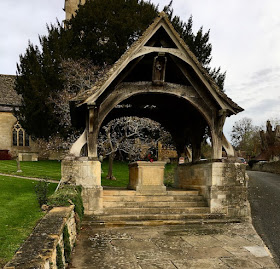Acts of remembrance
Listening to an excellent talk on Arts and Crafts war memorials given by Kirsty Hartsiotis last month, I was reminded of a very special war memorial at Overbury in Worcestershire. This is not only a war memorial but also a building – the lych-gate through which one enters the churchyard of St Faith’s church. Like so much of the architecture of this village it came about through the care and generosity of the Martin and Holland-Martin familes, once the owners of one of Britain’s largest banks. The Martins live in the large house just visible from the churchyard and employed architects and craftsmen working in the vernacular and Arts and Crafts traditions to construct a school, a village hall, even a bus shelter. It was natural, then, when 19-year-old Geoffrey Holland-Martin was killed in action in France in 1918, that his parents should think not just in terms of a personal memorial to his son but also of something more widely relevant to the village. Hence this lych-gate, which combines a memorial to those in the village who fell in the Great War with a monumental entrance to the churchyard.
The architect was no less than Sir Herbert Baker, who had imbibed vernacular and Arts and Crafts ways of building when as a young man he was assistant to the prominent practice of Ernest George and Peto. He subsequently had a busy life, packing in what almost amounted to three consecutive architectural careers. After a promising start in London, he followed his brother (a fruit farmer) to southern Africa, met Cecil Rhodes, and designed a string of buildings for private clients, the church, and the colonial government. Next he went to India and worked with Lutyens on New Delhi. By the time World War I ended, Baker was in his fifties and might have rested on his laurels. But this was not Baker’s way. Instead, he became architect to the then Imperial War Grave Commission, designing 113 cemeteries on the western front.
Baker’s building at Overbury is on a tiny scale compared to these grand projects, but it’s designed with plenty of care. It wonderfully combines a monumental quality with the use of oak and limestone, materials that feel completely at home in this stone village where, on some days, the most obvious sound is the wind stirring the leaves of great trees. The wooden superstructure that rests on the limestone plinth is certainly imposing, with its large arches, but it’s also inviting, an irrestistable draw both to the eye and to the feet. ‘Come to church, good people,’ it seems to say, to those who have arrived through countryside in which Bredon Hill rises in the middle distance.
In the centre of the interior is a large coffin rest, a reminder of the time when the bearers paused in the lych-gate while the priest said the first part of the burial service. This is designed in the shape of a chest tomb, and this has reminded more than one person of a cenotaph, an empty tomb like the one in Whitehall that acts as a focus for national remembrance ceremonies. From thoughts of those laid in earth to thoughts of the celestial: the other special thing about this structure is the carvings of angels resting in those massive wooden beams. They are by Alec Miller, who was head of wood-carving and modelling in the Campden Guild of Handicraft when the lych-gate was built. My photograph shows the angel on the side of the lych-gate pointing towards the church, its wings outstretched.
The northern face of the coffin rest is carved with the lines from Blake’s poem Jerusalem that speak of building Jerusalem ‘in England’s green and pleasant land’. For many rural people in the interwar period, England was far from green and pleasant, but thanks to the Holland-Martins, Overbury seems to have made at least the aspiration credible.


No comments:
Post a Comment